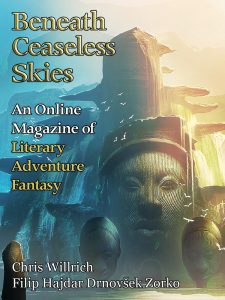Karen Burnham Reviews Short Fiction: Beneath Ceaseless Skies, Clarkesworld, Tor.com and Strange Horizons
 Beneath Ceaseless Skies 10/7/21
Beneath Ceaseless Skies 10/7/21
Clarkesworld 10/21
Tor.com 9/8, 9/15, 9/29, 10/13, 10/20/21
Strange Horizons 9/13/21
Beneath Ceaseless Skies is a strong, high-quality venue, week in and week out, but on anniversaries and big milestones editor Scott Andrews pulls out the stops. For the 13th Anniversary we get a double issue filled with magic. First up is “The Burning Girl” by Carrie Vaughn, an alternate history in which William the Conqueror is helped by Sir Gilbert who gathers to him people with extraordinary powers – what we’d think of as superpowers but deemed cursed at the time. The narrator is a girl with fire powers who had been confined to an abbey before Sir Gilbert’s arrival. His band of six individuals is enough to take York, but kings are not always faithful in their promises. It’s a lot of fun as well as being historically nuanced. From K.J. Parker we have “Stronger”, a reimagining of the Minotaur legend. The narrator, a young man from a prosperous family, lost his love to the lottery that chooses victims to be taken to the Black Island. We learn how this system came to be, and also about his theory that the Minotaur story can’t be real, that something else must be happening to the victims. He comes up with a plan to get himself to the Black Island, where there is even more weirdness to discover. Parker’s voice is always enjoyable in stories like these, full of matter-of-fact observations about the fantastic and bizarre worlds through which his characters move. R.K. Duncan brings us another tale rooted in Greek myth in “Nemesis and the Sorcerer”. Young Nikanor is a Cadmean scout and eager to prove himself to his erastes, Orios, on their mission to rescue a sorcerer and escort him from Spartan lands. The raid goes badly and they end up holed up in a tomb, where the sorcerer gives Nikanor access to the underworld to scout out potential escape routes. However, it is not safe to dabble with godlike powers when the gods are real. I feel like a lot of research went into this one. Finally there is “Song So Pure and Cruel” by March McCarron, based this time in Celtic mythology. A baby pooka is frightened out to sea and rescued by an incarnation of the Moon goddess Danu. They’re both young, and they grow up together, sharing in playful delights that evolve into a deep love. Their idyll is marred only by the Faerie King, who is determined that Danu should produce an heir for him, willingly or not. The story is told from the pooka’s point of view, which is charmingly impish, and I really like how both the voice and the character evolve at the end.
October’s Clarkesworld is filled with all sorts of science fictional imaginings. There’s a lot to ponder here. “Legend of the Giant” by Fei Dao (translated by Ken Liu) has a giant robot at the end of the world, motivated by a philosophical bug. The robot goes on a highly considered mission of destruction across the lifeless landscape, trying to tear things down in a way that allows for renewal. After meeting another robot and further conversation with the bug, he starts to think bigger thoughts about his life and meaning. There are a lot of layers here, especially philosophically. Another story with multiple moving parts is “Rain Falling in the Pines” by Lavie Tidhar. In this future First Humans (Neanderthals) have been revived and are living in a section of the Holy Land – there are also Martians and uplifted octopodes and variously genetically modified humans and possibly even stranger things all the way out to the Oort Cloud. So when First Human Geshem finds himself in the possession of an obviously modified roc egg, he wants to get rid of it as fast as possible, but various factions violently close in on him before he can even attempt to sell it. I appreciate the way Tidhar really plays out and pays off the ending here. M.L. Clark’s story “Love Unflinching, at Low- to Zero-G” is another that plays with the interactions of multiple alien species, something I’ve really enjoyed about her stories. In this one Doc is a human veterinarian on a space station full of both citizen species and their non-citizen pets. He helps dogs, parrots, hamsters, and even a group of horses which panicked after finding themselves in zero g. One species of “pet,” the Murr, are adopted by humans as something of a fad… which is unfortunate considering that the citizen species native to their home planet considers them sacred and does not tolerate any ill-treatment of them. To say that finding out that some people have been genemodding the Murrs to make them more attractive to humans would cause an interstellar incident is an understatement, and in the great James Herriot tradition it’s up to our noble vet to chart the best course through both the medical and psychological needs of his clients.
Other stories here are shorter, more traditional tales focused on dramatizing a primary idea. Brenda Cooper imagines how non-fungible tokens (NFTs) could possibly help an under-funded elephant rescue effort in “Paper of Elephants”. Bo Balder’s story “The Answer Was Snails” has humans cooped up in an alien terrarium that is only marginally supportive of their biological needs and not at all of their psychological ones. Our hero wants to find a way out of his jungle habitat, into the desert habitat where he can see another human, but how to climb the sheer glass walls? “Through” by Eric Fomley & Rich Larson imagines a man trapped in a sadistic prison when someone from the outside launches a rescue effort; but as he travels through its labyrinthine corridors it seems like the prison is oddly tailored specifically to him. His reality shifts several times through the surreal journey.
Tor.com continues to highlight stories that are full of atmosphere as well as plot. “The Station of the Twelfth” by Chaz Brenchley imagines a train station set on a very different Mars, one that commemorates the Twelfth Battalion that protected the evacuation of Deimos when the Russians took it. Set in his Mars Imperial universe, this has much of the poignance of “The Last of the Light Brigade”. From Lavie Tidhar we get the next installment in his Judge Dee vampire mystery stories, “Judge Dee and the Poisoner of Montmartre”. This story is set in Paris and the victim is the inquisitor Zaragoza, much hated for his cruelty towards both the living while he was alive and to the undead once he turned. In this locked-room murder any vampire present has motivation to have done the deed, including the good Judge himself. It should be noted that Judge Dee has also taken a particular liking to the theatre, even the street productions in Paris, much to the dismay of his human servant Jonathan. A.T. Greenblatt gets weird in “Questions Asked in the Belly of the World”, featuring a completely subterranean world, complete with mushrooms and spores. Kenji and Eva live in a society where everyone has a parasitic “voice” that speaks to them and enforces the norm that art is the highest and only calling. This is a problem for Kenji twice over, since he’s an inventor more than an artist and his voice appears to be dying – when your voice dies you are tied to a funeral barge and sent down the river, whether the rest of you is dead or not. Eva is a free spirit who uses Kenji’s invention in her artwork, and she has always distrusted her voice. She seeks a way to save Kenji and replace his voice, and they both start questioning everything about the world that they’ve been taught.
The last two stories I saw both deal with the consequences of the baggage you carry from your parents and your upbringing. “Sand” by Jasmin Kirkbride imagines a world where even a baby’s mouth is stuffed with sand. Everyone has a way of dealing with the sand in their mouths – Suzy’s mother hides it gracefully while her father tries to swallow his down each day (trying this only makes Suzy sicker). There may be a way to get rid of the sand altogether, but it’s a hard path made harder by the taboo surrounding discussing the sand at all. The metaphor here is clear as a bell. From E. Lily Yu we learn the story of “Small Monsters”. This particular small monster can regenerate, so its parent doesn’t hesitate to snack on a limb or two whenever its hunt goes badly. The small monster manages to escape, but others out in the world also value it more for its deliciousness than for itself. It finally gets itself all the way to a deserted shore where it befriends a clawed creature that starts decorating the small monster, adding bits of sea glass and gold coins to its scales using anemone glue. The small monster’s troubles are not over as figures from the rest of its life come searching for it on the shore, but just maybe it can find the strength to fight them off.
In Strange Horizons in September we have a fascinating novelette, “An Exploration of Nichole Otieno’s Early Filmography (1232-1246)” by Kola Heyward-Rotimi. This is a story in the form of an academic paper, one in which the paper’s author is unabashedly mixing memoir with analysis. He returns to the islands that were his home, searching for lost film fragments from the director Otieno. The islands were the site of colonization and overthrow, but even after a freedom movement the legacy of colonialism still lingers. It’s in this context that the search takes place: the narrator is between worlds as an academic at a mainland university but also an islander returning home. He participates in rituals but isn’t sure how he fits, and all this colors his analysis of the three film fragments he finds, each an angle into the work of a director also charting a course through these complicated cultural waters. There is a lot of world-building here, and many phenomena that remain appropriately ambiguous. This is one that will reward re-reading.
Karen Burnham is an electromagnetics engineer by way of vocation, and a book reviewer/critic by way of avocation. She has worked on NASA projects including the Dream Chaser spacecraft and currently works in the automotive industry in Michigan. She has reviewed for venues such as Locus Magazine, NYRSF, Strange Horizons, SFSignal.com, and Cascadia Subduction Zone. She has produced podcasts for Locusmag.com and SFSignal.com, especially SF Crossing the Gulf with Karen Lord. Her book on Greg Egan came out from University of Illinois Press in 2014, and she has twice been nominated in the Best Non-Fiction category of the British SF Awards.
This review and more like it in the December 2021 issue of Locus.
 While you are here, please take a moment to support Locus with a one-time or recurring donation. We rely on reader donations to keep the magazine and site going, and would like to keep the site paywall free, but WE NEED YOUR FINANCIAL SUPPORT to continue quality coverage of the science fiction and fantasy field.
While you are here, please take a moment to support Locus with a one-time or recurring donation. We rely on reader donations to keep the magazine and site going, and would like to keep the site paywall free, but WE NEED YOUR FINANCIAL SUPPORT to continue quality coverage of the science fiction and fantasy field.
©Locus Magazine. Copyrighted material may not be republished without permission of LSFF.







